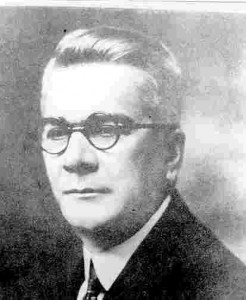Gerardo Machado y Morales (September 28, 1871, Camajuaní – March 29, 1939, Miami Beach, Florida) was President of Cuba (1925–1933) and a general of the Cuban War of Independence. He was born in the central Province of Las Villas (now Villa Clara) and was from a poor background.
He married Elvira Machado Nodal (28 October 1868 in Villa Clara – 1968) and they had three daughters; Laudelina (Nena), Ángela Elvira and Berta.[1] Machado also had two children out of wedlock, Leonor and Heriberto Machado.
Youth
He was said to have been a cattle rustler before he joined the fight for independence.
War experience
He rustled cattle from the Spanish Imperial Army for distribution to the starving Cuban People, who were denied such food for their children. General Machado was the oldest brother of Colonel Lorenzo Machado-Morales of the Cuban Mambi army of Las Villas Province under General Calixto Garcia. General Machado was one of the youngest Cuban generals of the 1895 to 1898 Cuban War of Independence. Only two other War of Independence generals were younger: Calixto Enamorado (1874–1951)[3] and Enrique Loynaz del Castillo (1871–1963),. Gerardo Machado fought in the middle provinces[6] along with José Miguel Gómez (1858–1921) who also was president on the Liberal Party ticket and José de Jesús Monteagudo who would later defeat the disorganized black separatist forces of Evaristo Estenoz and Pedro Ivonet in the 1912 Race War and cruelly crush this rebellion.
Machado, said to the party’s War leader in Las Villas province, fought on the defeated Liberal side in the 1917 “Little War of February 1917” La Chambelona (Chambelona War), with José Miguel Gómez, Alfredo Zayas and with Enrique Loynaz del Castillo. Calixto Enamorado fought on the Conservative side. After the initial victories of the Liberals, things turned worse. Yet Machado continued to fight even after the Liberals lost to the machine guns of Colonel Rosendo Collazo at Caicaje once the hacienda of Santiago Saura Orraque[9] and Juan Manuel Perez de la Cruz[10] on 8 March until his cause was unsustainable and surrendered.
President Mario García Menocal had clearly won. Technically there was no US intervention in this war and Cuban Army Offices notably Julio Sanguilí, in Santiago, regained control. Since in this war the Liberals were said to be pro-German, US President Woodrow Wilson, worried about Mexico and Pancho Villa, and the loss of able general, Menocal’s friend and Cuba hand Frederick Funston had one less distraction on his hands. Menocal declared war on Germany April 7 of that same year. John J. Pershing, less tactful than Funston, in the Cuban circumstance, would be sent first to Mexico and then Europe.
Political life
A political figure, he served in the Liberal Party Administration of José Miguel Gómez. Allied with his predecessor outgoing president Alfredo Zayas and running as a Liberal Party candidate, he defeated Mario García Menocal of the Conservative Party by an overwhelming majority to become Cuba’s 5th president. He took office as President of Cuba on May 20, 1925 and left office on August 12, 1933. Elected at the time of a fall in world sugar prices, he was a Cuban industrialist and member of the political elite of the Liberal Party.
Machado believed in the infant industry argument for protectionism. This led him to support the Vejeda Act of 1926, which attempted to raise sugar prices by cutting production, and the Customs-Tariff Law of 1927.Machado supported construction of the Central Highway.
Politically he was less adroit, he determined to make Cuba the “Switzerland of the Americas.” His detractors claimed that he became despotic and forced his way into a second term. According to his critics, Machado abused and censored the press.The struggles against Machado have influenced both film[18] and literature. It was in these turbulent times, when Machado ruled, that Cuban links to the Stalinist Communist International were made for the first time by Fabio Grobart.
Turbulent times erupted in Cuba when the newly formed Communist Party began to destabilize the nation by allegedly committing terrorist acts of placing and exploding bombs in hotels and movie theatres in Havana, killing innocent men, women and children. President Machado threw Cuba into Martial Law as a result, while a partisan leftist media criticized the action taken by the 5th Cuban President.[citation needed] Although Machado is said to have ordered the murder of defecting communist Julio Antonio Mella in Mexico this murder is generally conceded to have been carried out by the Stalinist faction of the Communist International who were in a death struggle with the followers of Leon Trotsky.[citation needed] The actual assassination was probably done by an action group that included notorious communist assassin Vittorio Vidali. Trotsky was eventually also murdered in that country by communist assassin Ramón Mercader.
Machado loses power
In Cuba, Machado engaged in a long struggle with diverse insurgent groups which varied from the green shirts of the ABC to Blas Hernández, to the conservative veterans of the Cuban War of Independence to the radical Antonio Guiteras group, and clung on for several years. He was finally toppled in the 1933 by US influence, Sumner Welles, Cuban War of Independence veterans, Army officers and civic leaders in a general strike (Alba, 1968). His government’s collapse was followed by a revolution led by dissident students, labor activists, and non-commissioned military officers, that left the power in the hands of Fulgencio Batista.
http://vimeo.com/6098761
He died in Miami Beach and is entombed in Miami at Woodlawn Park Cemetery and Mausoleum (now Caballero Rivero Woodlawn North Park Cemetery and Mausoleum). He has a few descendants in Germany, Florida, and Panama; their last names are Jones, Reyez, and some still have Machado.
Sources: Wiki/InternetPhoto/TheCubanHistory.com




